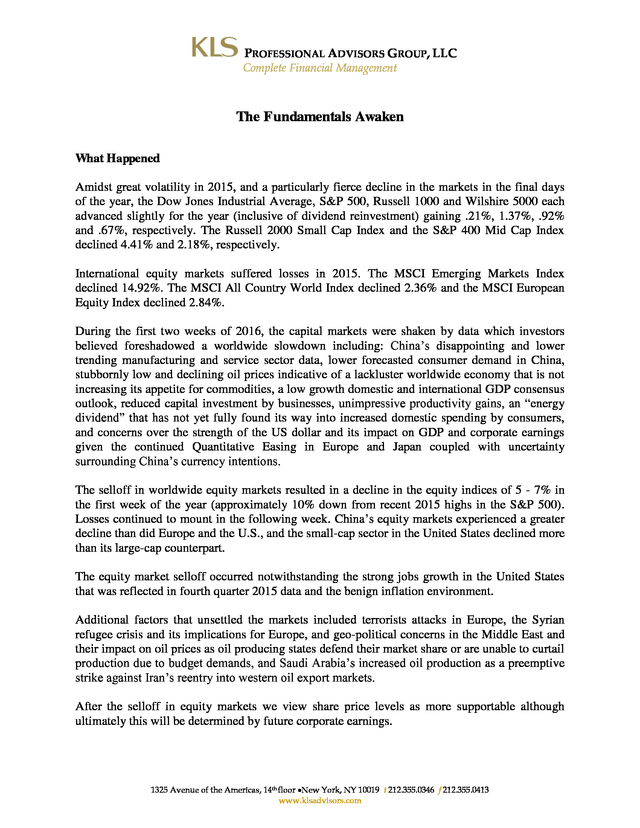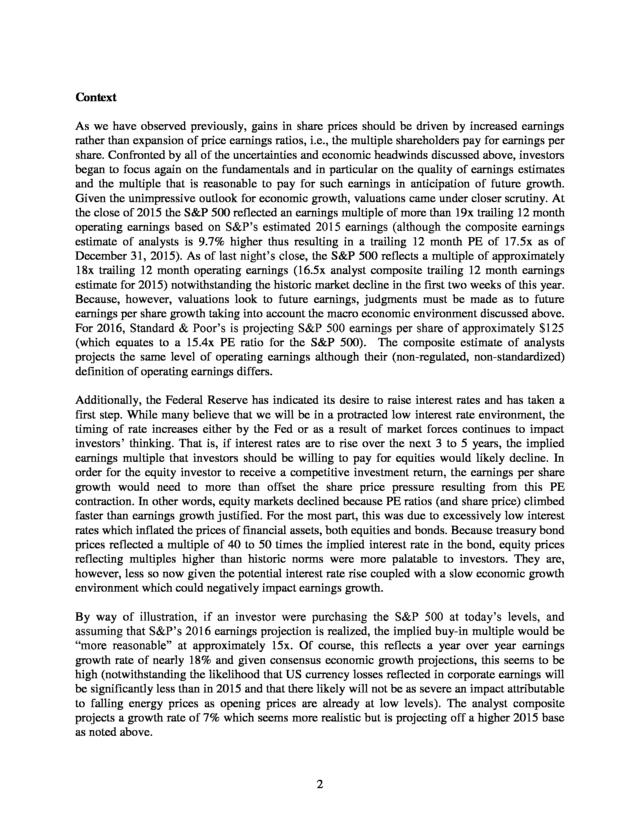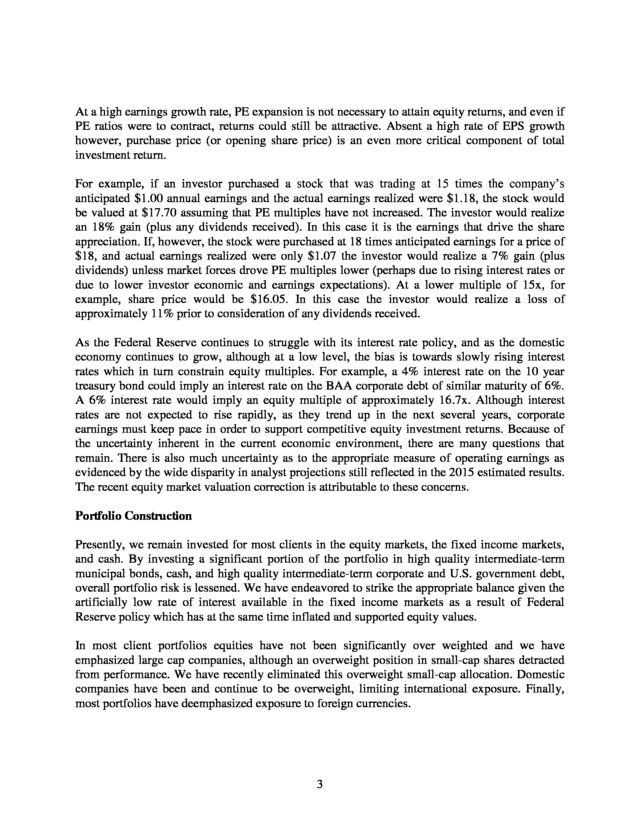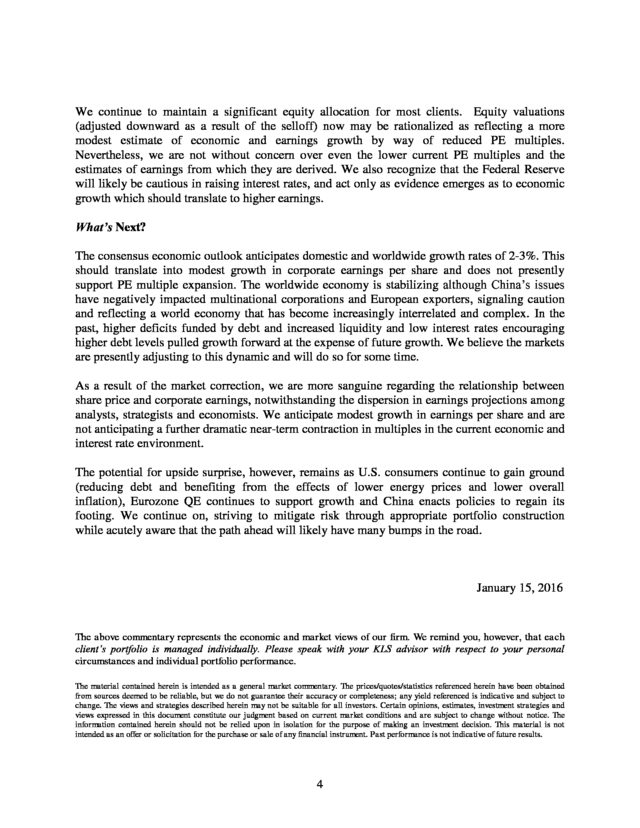Description
PROFESSIONAL ADVISORS GROUP, LLC
Complete Financial Management
The Fundamentals Awaken
What Happened
Amidst great volatility in 2015, and a particularly fierce decline in the markets in the final days
of the year, the Dow Jones Industrial Average, S&P 500, Russell 1000 and Wilshire 5000 each
advanced slightly for the year (inclusive of dividend reinvestment) gaining .21%, 1.37%, .92%
and .67%, respectively. The Russell 2000 Small Cap Index and the S&P 400 Mid Cap Index
declined 4.41% and 2.18%, respectively.
International equity markets suffered losses in 2015. The MSCI Emerging Markets Index
declined 14.92%. The MSCI All Country World Index declined 2.36% and the MSCI European
Equity Index declined 2.84%.
During the first two weeks of 2016, the capital markets were shaken by data which investors
believed foreshadowed a worldwide slowdown including: China’s disappointing and lower
trending manufacturing and service sector data, lower forecasted consumer demand in China,
stubbornly low and declining oil prices indicative of a lackluster worldwide economy that is not
increasing its appetite for commodities, a low growth domestic and international GDP consensus
outlook, reduced capital investment by businesses, unimpressive productivity gains, an “energy
dividend” that has not yet fully found its way into increased domestic spending by consumers,
and concerns over the strength of the US dollar and its impact on GDP and corporate earnings
given the continued Quantitative Easing in Europe and Japan coupled with uncertainty
surrounding China’s currency intentions.
The selloff in worldwide equity markets resulted in a decline in the equity indices of 5 - 7% in
the first week of the year (approximately 10% down from recent 2015 highs in the S&P 500).
Losses continued to mount in the following week.
China’s equity markets experienced a greater decline than did Europe and the U.S., and the small-cap sector in the United States declined more than its large-cap counterpart. The equity market selloff occurred notwithstanding the strong jobs growth in the United States that was reflected in fourth quarter 2015 data and the benign inflation environment. Additional factors that unsettled the markets included terrorists attacks in Europe, the Syrian refugee crisis and its implications for Europe, and geo-political concerns in the Middle East and their impact on oil prices as oil producing states defend their market share or are unable to curtail production due to budget demands, and Saudi Arabia’s increased oil production as a preemptive strike against Iran’s reentry into western oil export markets. After the selloff in equity markets we view share price levels as more supportable although ultimately this will be determined by future corporate earnings. 1325 Avenue of the Americas, 14th floor ï‚·New York, NY 10019 t 212.355.0346 f 212.355.0413 www.klsadvisors.com . Context As we have observed previously, gains in share prices should be driven by increased earnings rather than expansion of price earnings ratios, i.e., the multiple shareholders pay for earnings per share. Confronted by all of the uncertainties and economic headwinds discussed above, investors began to focus again on the fundamentals and in particular on the quality of earnings estimates and the multiple that is reasonable to pay for such earnings in anticipation of future growth. Given the unimpressive outlook for economic growth, valuations came under closer scrutiny. At the close of 2015 the S&P 500 reflected an earnings multiple of more than 19x trailing 12 month operating earnings based on S&P’s estimated 2015 earnings (although the composite earnings estimate of analysts is 9.7% higher thus resulting in a trailing 12 month PE of 17.5x as of December 31, 2015). As of last night’s close, the S&P 500 reflects a multiple of approximately 18x trailing 12 month operating earnings (16.5x analyst composite trailing 12 month earnings estimate for 2015) notwithstanding the historic market decline in the first two weeks of this year. Because, however, valuations look to future earnings, judgments must be made as to future earnings per share growth taking into account the macro economic environment discussed above. For 2016, Standard & Poor’s is projecting S&P 500 earnings per share of approximately $125 (which equates to a 15.4x PE ratio for the S&P 500).
The composite estimate of analysts projects the same level of operating earnings although their (non-regulated, non-standardized) definition of operating earnings differs. Additionally, the Federal Reserve has indicated its desire to raise interest rates and has taken a first step. While many believe that we will be in a protracted low interest rate environment, the timing of rate increases either by the Fed or as a result of market forces continues to impact investors’ thinking. That is, if interest rates are to rise over the next 3 to 5 years, the implied earnings multiple that investors should be willing to pay for equities would likely decline.
In order for the equity investor to receive a competitive investment return, the earnings per share growth would need to more than offset the share price pressure resulting from this PE contraction. In other words, equity markets declined because PE ratios (and share price) climbed faster than earnings growth justified. For the most part, this was due to excessively low interest rates which inflated the prices of financial assets, both equities and bonds.
Because treasury bond prices reflected a multiple of 40 to 50 times the implied interest rate in the bond, equity prices reflecting multiples higher than historic norms were more palatable to investors. They are, however, less so now given the potential interest rate rise coupled with a slow economic growth environment which could negatively impact earnings growth. By way of illustration, if an investor were purchasing the S&P 500 at today’s levels, and assuming that S&P’s 2016 earnings projection is realized, the implied buy-in multiple would be “more reasonable” at approximately 15x. Of course, this reflects a year over year earnings growth rate of nearly 18% and given consensus economic growth projections, this seems to be high (notwithstanding the likelihood that US currency losses reflected in corporate earnings will be significantly less than in 2015 and that there likely will not be as severe an impact attributable to falling energy prices as opening prices are already at low levels).
The analyst composite projects a growth rate of 7% which seems more realistic but is projecting off a higher 2015 base as noted above. 2 . At a high earnings growth rate, PE expansion is not necessary to attain equity returns, and even if PE ratios were to contract, returns could still be attractive. Absent a high rate of EPS growth however, purchase price (or opening share price) is an even more critical component of total investment return. For example, if an investor purchased a stock that was trading at 15 times the company’s anticipated $1.00 annual earnings and the actual earnings realized were $1.18, the stock would be valued at $17.70 assuming that PE multiples have not increased. The investor would realize an 18% gain (plus any dividends received). In this case it is the earnings that drive the share appreciation.
If, however, the stock were purchased at 18 times anticipated earnings for a price of $18, and actual earnings realized were only $1.07 the investor would realize a 7% gain (plus dividends) unless market forces drove PE multiples lower (perhaps due to rising interest rates or due to lower investor economic and earnings expectations). At a lower multiple of 15x, for example, share price would be $16.05. In this case the investor would realize a loss of approximately 11% prior to consideration of any dividends received. As the Federal Reserve continues to struggle with its interest rate policy, and as the domestic economy continues to grow, although at a low level, the bias is towards slowly rising interest rates which in turn constrain equity multiples.
For example, a 4% interest rate on the 10 year treasury bond could imply an interest rate on the BAA corporate debt of similar maturity of 6%. A 6% interest rate would imply an equity multiple of approximately 16.7x. Although interest rates are not expected to rise rapidly, as they trend up in the next several years, corporate earnings must keep pace in order to support competitive equity investment returns. Because of the uncertainty inherent in the current economic environment, there are many questions that remain.
There is also much uncertainty as to the appropriate measure of operating earnings as evidenced by the wide disparity in analyst projections still reflected in the 2015 estimated results. The recent equity market valuation correction is attributable to these concerns. Portfolio Construction Presently, we remain invested for most clients in the equity markets, the fixed income markets, and cash. By investing a significant portion of the portfolio in high quality intermediate-term municipal bonds, cash, and high quality intermediate-term corporate and U.S. government debt, overall portfolio risk is lessened.
We have endeavored to strike the appropriate balance given the artificially low rate of interest available in the fixed income markets as a result of Federal Reserve policy which has at the same time inflated and supported equity values. In most client portfolios equities have not been significantly over weighted and we have emphasized large cap companies, although an overweight position in small-cap shares detracted from performance. We have recently eliminated this overweight small-cap allocation. Domestic companies have been and continue to be overweight, limiting international exposure.
Finally, most portfolios have deemphasized exposure to foreign currencies. 3 . We continue to maintain a significant equity allocation for most clients. Equity valuations (adjusted downward as a result of the selloff) now may be rationalized as reflecting a more modest estimate of economic and earnings growth by way of reduced PE multiples. Nevertheless, we are not without concern over even the lower current PE multiples and the estimates of earnings from which they are derived. We also recognize that the Federal Reserve will likely be cautious in raising interest rates, and act only as evidence emerges as to economic growth which should translate to higher earnings. What’s Next? The consensus economic outlook anticipates domestic and worldwide growth rates of 2-3%. This should translate into modest growth in corporate earnings per share and does not presently support PE multiple expansion.
The worldwide economy is stabilizing although China’s issues have negatively impacted multinational corporations and European exporters, signaling caution and reflecting a world economy that has become increasingly interrelated and complex. In the past, higher deficits funded by debt and increased liquidity and low interest rates encouraging higher debt levels pulled growth forward at the expense of future growth. We believe the markets are presently adjusting to this dynamic and will do so for some time. As a result of the market correction, we are more sanguine regarding the relationship between share price and corporate earnings, notwithstanding the dispersion in earnings projections among analysts, strategists and economists.
We anticipate modest growth in earnings per share and are not anticipating a further dramatic near-term contraction in multiples in the current economic and interest rate environment. The potential for upside surprise, however, remains as U.S. consumers continue to gain ground (reducing debt and benefiting from the effects of lower energy prices and lower overall inflation), Eurozone QE continues to support growth and China enacts policies to regain its footing. We continue on, striving to mitigate risk through appropriate portfolio construction while acutely aware that the path ahead will likely have many bumps in the road. January 15, 2016 The above commentary represents the economic and market views of our firm.
We remind you, however, that each client’s portfolio is managed individually. Please speak with your KLS advisor with respect to your personal circumstances and individual portfolio performance. The material contained herein is intended as a general market commentary. The prices/quotes/statistics referenced herein have been obtained from sources deemed to be reliable, but we do not guarantee their accuracy or completeness; any yield referenced is indicative and subject to change.
The views and strategies described herein may not be suitable for all investors. Certain opinions, estimates, investment strategies and views expressed in this document constitute our judgment based on current market conditions and are subject to change without notice. The information contained herein should not be relied upon in isolation for the purpose of making an investment decision.
This material is not intended as an offer or solicitation for the purchase or sale of any financial instrument. Past performance is not indicative of future results. 4 .
China’s equity markets experienced a greater decline than did Europe and the U.S., and the small-cap sector in the United States declined more than its large-cap counterpart. The equity market selloff occurred notwithstanding the strong jobs growth in the United States that was reflected in fourth quarter 2015 data and the benign inflation environment. Additional factors that unsettled the markets included terrorists attacks in Europe, the Syrian refugee crisis and its implications for Europe, and geo-political concerns in the Middle East and their impact on oil prices as oil producing states defend their market share or are unable to curtail production due to budget demands, and Saudi Arabia’s increased oil production as a preemptive strike against Iran’s reentry into western oil export markets. After the selloff in equity markets we view share price levels as more supportable although ultimately this will be determined by future corporate earnings. 1325 Avenue of the Americas, 14th floor ï‚·New York, NY 10019 t 212.355.0346 f 212.355.0413 www.klsadvisors.com . Context As we have observed previously, gains in share prices should be driven by increased earnings rather than expansion of price earnings ratios, i.e., the multiple shareholders pay for earnings per share. Confronted by all of the uncertainties and economic headwinds discussed above, investors began to focus again on the fundamentals and in particular on the quality of earnings estimates and the multiple that is reasonable to pay for such earnings in anticipation of future growth. Given the unimpressive outlook for economic growth, valuations came under closer scrutiny. At the close of 2015 the S&P 500 reflected an earnings multiple of more than 19x trailing 12 month operating earnings based on S&P’s estimated 2015 earnings (although the composite earnings estimate of analysts is 9.7% higher thus resulting in a trailing 12 month PE of 17.5x as of December 31, 2015). As of last night’s close, the S&P 500 reflects a multiple of approximately 18x trailing 12 month operating earnings (16.5x analyst composite trailing 12 month earnings estimate for 2015) notwithstanding the historic market decline in the first two weeks of this year. Because, however, valuations look to future earnings, judgments must be made as to future earnings per share growth taking into account the macro economic environment discussed above. For 2016, Standard & Poor’s is projecting S&P 500 earnings per share of approximately $125 (which equates to a 15.4x PE ratio for the S&P 500).
The composite estimate of analysts projects the same level of operating earnings although their (non-regulated, non-standardized) definition of operating earnings differs. Additionally, the Federal Reserve has indicated its desire to raise interest rates and has taken a first step. While many believe that we will be in a protracted low interest rate environment, the timing of rate increases either by the Fed or as a result of market forces continues to impact investors’ thinking. That is, if interest rates are to rise over the next 3 to 5 years, the implied earnings multiple that investors should be willing to pay for equities would likely decline.
In order for the equity investor to receive a competitive investment return, the earnings per share growth would need to more than offset the share price pressure resulting from this PE contraction. In other words, equity markets declined because PE ratios (and share price) climbed faster than earnings growth justified. For the most part, this was due to excessively low interest rates which inflated the prices of financial assets, both equities and bonds.
Because treasury bond prices reflected a multiple of 40 to 50 times the implied interest rate in the bond, equity prices reflecting multiples higher than historic norms were more palatable to investors. They are, however, less so now given the potential interest rate rise coupled with a slow economic growth environment which could negatively impact earnings growth. By way of illustration, if an investor were purchasing the S&P 500 at today’s levels, and assuming that S&P’s 2016 earnings projection is realized, the implied buy-in multiple would be “more reasonable” at approximately 15x. Of course, this reflects a year over year earnings growth rate of nearly 18% and given consensus economic growth projections, this seems to be high (notwithstanding the likelihood that US currency losses reflected in corporate earnings will be significantly less than in 2015 and that there likely will not be as severe an impact attributable to falling energy prices as opening prices are already at low levels).
The analyst composite projects a growth rate of 7% which seems more realistic but is projecting off a higher 2015 base as noted above. 2 . At a high earnings growth rate, PE expansion is not necessary to attain equity returns, and even if PE ratios were to contract, returns could still be attractive. Absent a high rate of EPS growth however, purchase price (or opening share price) is an even more critical component of total investment return. For example, if an investor purchased a stock that was trading at 15 times the company’s anticipated $1.00 annual earnings and the actual earnings realized were $1.18, the stock would be valued at $17.70 assuming that PE multiples have not increased. The investor would realize an 18% gain (plus any dividends received). In this case it is the earnings that drive the share appreciation.
If, however, the stock were purchased at 18 times anticipated earnings for a price of $18, and actual earnings realized were only $1.07 the investor would realize a 7% gain (plus dividends) unless market forces drove PE multiples lower (perhaps due to rising interest rates or due to lower investor economic and earnings expectations). At a lower multiple of 15x, for example, share price would be $16.05. In this case the investor would realize a loss of approximately 11% prior to consideration of any dividends received. As the Federal Reserve continues to struggle with its interest rate policy, and as the domestic economy continues to grow, although at a low level, the bias is towards slowly rising interest rates which in turn constrain equity multiples.
For example, a 4% interest rate on the 10 year treasury bond could imply an interest rate on the BAA corporate debt of similar maturity of 6%. A 6% interest rate would imply an equity multiple of approximately 16.7x. Although interest rates are not expected to rise rapidly, as they trend up in the next several years, corporate earnings must keep pace in order to support competitive equity investment returns. Because of the uncertainty inherent in the current economic environment, there are many questions that remain.
There is also much uncertainty as to the appropriate measure of operating earnings as evidenced by the wide disparity in analyst projections still reflected in the 2015 estimated results. The recent equity market valuation correction is attributable to these concerns. Portfolio Construction Presently, we remain invested for most clients in the equity markets, the fixed income markets, and cash. By investing a significant portion of the portfolio in high quality intermediate-term municipal bonds, cash, and high quality intermediate-term corporate and U.S. government debt, overall portfolio risk is lessened.
We have endeavored to strike the appropriate balance given the artificially low rate of interest available in the fixed income markets as a result of Federal Reserve policy which has at the same time inflated and supported equity values. In most client portfolios equities have not been significantly over weighted and we have emphasized large cap companies, although an overweight position in small-cap shares detracted from performance. We have recently eliminated this overweight small-cap allocation. Domestic companies have been and continue to be overweight, limiting international exposure.
Finally, most portfolios have deemphasized exposure to foreign currencies. 3 . We continue to maintain a significant equity allocation for most clients. Equity valuations (adjusted downward as a result of the selloff) now may be rationalized as reflecting a more modest estimate of economic and earnings growth by way of reduced PE multiples. Nevertheless, we are not without concern over even the lower current PE multiples and the estimates of earnings from which they are derived. We also recognize that the Federal Reserve will likely be cautious in raising interest rates, and act only as evidence emerges as to economic growth which should translate to higher earnings. What’s Next? The consensus economic outlook anticipates domestic and worldwide growth rates of 2-3%. This should translate into modest growth in corporate earnings per share and does not presently support PE multiple expansion.
The worldwide economy is stabilizing although China’s issues have negatively impacted multinational corporations and European exporters, signaling caution and reflecting a world economy that has become increasingly interrelated and complex. In the past, higher deficits funded by debt and increased liquidity and low interest rates encouraging higher debt levels pulled growth forward at the expense of future growth. We believe the markets are presently adjusting to this dynamic and will do so for some time. As a result of the market correction, we are more sanguine regarding the relationship between share price and corporate earnings, notwithstanding the dispersion in earnings projections among analysts, strategists and economists.
We anticipate modest growth in earnings per share and are not anticipating a further dramatic near-term contraction in multiples in the current economic and interest rate environment. The potential for upside surprise, however, remains as U.S. consumers continue to gain ground (reducing debt and benefiting from the effects of lower energy prices and lower overall inflation), Eurozone QE continues to support growth and China enacts policies to regain its footing. We continue on, striving to mitigate risk through appropriate portfolio construction while acutely aware that the path ahead will likely have many bumps in the road. January 15, 2016 The above commentary represents the economic and market views of our firm.
We remind you, however, that each client’s portfolio is managed individually. Please speak with your KLS advisor with respect to your personal circumstances and individual portfolio performance. The material contained herein is intended as a general market commentary. The prices/quotes/statistics referenced herein have been obtained from sources deemed to be reliable, but we do not guarantee their accuracy or completeness; any yield referenced is indicative and subject to change.
The views and strategies described herein may not be suitable for all investors. Certain opinions, estimates, investment strategies and views expressed in this document constitute our judgment based on current market conditions and are subject to change without notice. The information contained herein should not be relied upon in isolation for the purpose of making an investment decision.
This material is not intended as an offer or solicitation for the purchase or sale of any financial instrument. Past performance is not indicative of future results. 4 .

















